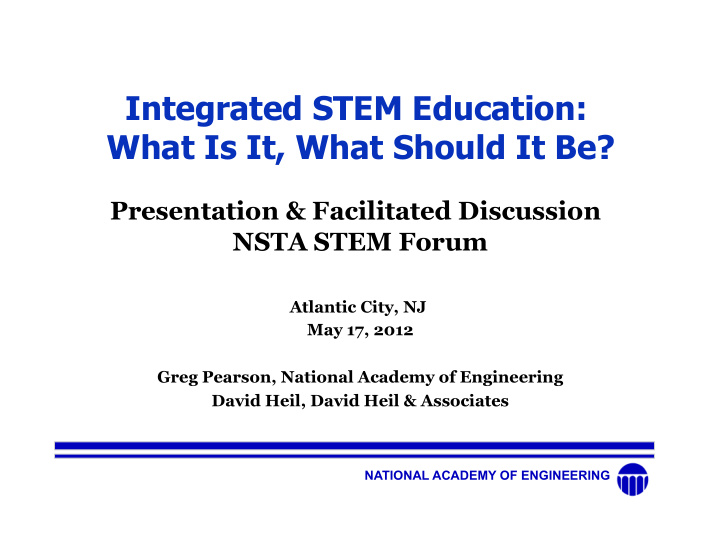



Integrated STEM Education: What Is It, What Should It Be? Presentation & Facilitated Discussion NSTA STEM Forum Atlantic City, NJ May 17, 2012 Greg Pearson, National Academy of Engineering David Heil, David Heil & Associates NATIONAL ACADEMY OF ENGINEERING
• Introductions • About the National Academies • STEM and iSTEM • The Study • Your Feedback NATIONAL ACADEMY OF ENGINEERING
The National Academy of Sciences was born in the travail of the Civil War. The Act of Incorporation, signed by President Lincoln on March 3, 1863, established service to the nation as its dominant purpose. The act also named 50 charter members. NATIONAL ACADEMY OF ENGINEERING
National Research Council – 1916 National Academy of Engineering – 1964 Institute of Medicine – 1970 NATIONAL ACADEMY OF ENGINEERING
Members elected by peers NAS and NAE have about 2300 each; IOM about 1600 NRC is organized into 5 major divisions NAE has a separate Program Office NATIONAL ACADEMY OF ENGINEERING
10,000 volunteer experts 700 studies About 260 reports each year 1,100 staff 85% of $290 mil. annual budget comes from the federal government NATIONAL ACADEMY OF ENGINEERING
Cell Cultures or Plant Parts? What is STEM Anyway? NATIONAL ACADEMY OF ENGINEERING
Seriously! In a recent survey of 5,000 people working in the aerospace industry, 85 percent said they did not know what STEM education is. Most associate the acronym with either plants or stem- cell research. NATIONAL ACADEMY OF ENGINEERING
But More Seriously STEM has become ubiquitous in education policy discussions, for good reason: » Key to the U.S. innovation engine » Supports quality of life » Creates economic value » Ties to broader scientific and technological literacy NATIONAL ACADEMY OF ENGINEERING
Reality Check on An “Accidental Acronym” = ? + + + S T E M NATIONAL ACADEMY OF ENGINEERING
Or is it Perhaps . . . ? = ? + + + S T E M NATIONAL ACADEMY OF ENGINEERING
Or Maybe Some Version of This . . . ? S T E M NATIONAL ACADEMY OF ENGINEERING
And is the “T” This? NATIONAL ACADEMY OF ENGINEERING
Or This? NATIONAL ACADEMY OF ENGINEERING
Back to the Future . . . “By ‘science,’ Project 2061 means basic and applied natural and social science, basic and applied mathematics, and engineering and technology, and their interconnections—which is to say the scientific enterprise as a whole. The basic point is that the ideas and practice of science, mathematics, and technology are so closely intertwined that we do not see how education in any one of them can be undertaken well in isolation from the others.” - Benchmarks for Science Literacy (1993) NATIONAL ACADEMY OF ENGINEERING
Education vs. the “Real World” “Although the term ‘STEM education’ is used in national education policy, it is not implemented in a way that reflects the interdependence of the four STEM subjects.” -NAE/NRC Committee on K-12 Engineering Education (2009) NATIONAL ACADEMY OF ENGINEERING
What Some (Would Like to) Believe Making connections between math and science can improve student learning and interest in both And/or . . . Science inquiry (now “practices”) provides motivation to learn science and provides a way to make math more relevant And/or . . . Engineering and technological design provide concrete application opportunities for math and science NATIONAL ACADEMY OF ENGINEERING
Academies Study on Integrated STEM Education GOAL Craft a research agenda for determining the value —in terms of student learning, achievement, motivation, career aspirations, and other factors —of integrated K-12 STEM (iSTEM) education in the United States. NATIONAL ACADEMY OF ENGINEERING
Study on Integrated STEM Education OBJECTIVES • Develop a descriptive framework, or taxonomy, for iSTEM education that can guide the work of the project committee and provide a structure for data gathering, analysis, and reporting. • Propose a research agenda that prioritizes a set of research questions, identifies possible methodologies for answering them, and suggests organizations that might conduct the work. NATIONAL ACADEMY OF ENGINEERING
Margaret Honey, Chair Richard Lehrer New York Hall of Science Peabody College, Vanderbilt University Linda Abriola Beth McGrath School of Engineering, Tufts University Stevens Institute of Technology Sybilla Beckmann Barbara Means University of Georgia Center for Technology in Learning. SRI Susan Hackwood Donna Migdol California Council on Science and Technology Oceanside School District, NY Alfred L. Hall II Mitchell Nathan University of Memphis University of Wisconsin, Madison Jennifer Hicks Mark Sanders Purdue University Virginia Tech Steve Krak Michael Town Ohio STEM Learning Network High School Science Teacher Redmond, WA Bill Kurtz Denver School of Science and Technology NATIONAL ACADEMY OF ENGINEERING
Study Status The study committee is in the discovery/learning phase. Key challenges to-date: 1. Definitional confusion surrounding the terms “integrated” and “STEM” 2. The existence of multiple models of iSTEM 3. Gap between promotional descriptions of programs and what is actually implemented 4. A relatively weak research base. Three of five planned meetings have been held. Report expected to be published in spring 2013. NATIONAL ACADEMY OF ENGINEERING
Our Questions for You! 1. What is iSTEM? 2. What is its “value proposition?” 3. What education research is needed to better determine the benefits of iSTEM? 4. Who should we be targeting as audiences for the project report? NATIONAL ACADEMY OF ENGINEERING
NATIONAL ACADEMY OF ENGINEERING
NATIONAL ACADEMY OF ENGINEERING
NATIONAL ACADEMY OF ENGINEERING
NATIONAL ACADEMY OF ENGINEERING
Greg Pearson, NAE gpearson@nae.edu David Heil, DHA dheil@davidheil.com NATIONAL ACADEMY OF ENGINEERING
Recommend
More recommend